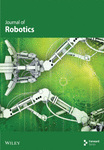Full-Body Optimization-Based Bipedal Walking Control With Task-Space Inverse Dynamics and Virtual Constraints
Abstract
Achieving stable and versatile bipedal locomotion remains a major challenge in robotics, with applications in personal assistance, healthcare, and search and rescue. The hybrid zero dynamics (HZD) framework, based on virtual constraints, has shown strong potential for generating provably stable gaits. However, traditional HZD implementations often rely on simple feedback controllers that lack the ability to strictly enforce physical constraints, such as actuator limits and ground contact conditions during real-time execution. This paper presents a full-body, optimization-based walking controller for a bipedal robot that integrates virtual-constraints-based gait planning with online tracking using task-space inverse dynamics (TSID). A gait library is generated offline using two different sets of virtual constraints. It is shown that constraints based on the center of mass (CoM) relative to the feet improve optimization performance, achieving 8% fewer iterations, 12% faster convergence, and an 11.6% better objective value compared to classical constraint sets. The TSID controller, formulated as a weighted quadratic program (WQP), enables simultaneous tracking of multiple task objectives while respecting dynamic consistency and physical constraints. Simulation results on the GR-1 humanoid robot demonstrate stable walking over a range of velocities, smooth transitions between walking speeds, and successful rejection of external disturbances up to 20 N·s, confirming the effectiveness and robustness of the proposed approach.
1. Introduction
Bipedal locomotion remains a challenging and highly researched area in robotics, motivated by potential applications in personal assistance, healthcare, and exploration of hazardous environments. Achieving dynamic and robust walking behaviors requires addressing issues of stability, underactuation, contact interactions, and the complexities of full-body dynamics.
Early approaches focused on maintaining static stability by keeping the center of mass (CoM) within the support area [1], later advancing to dynamic walking methods based on the zero moment point (ZMP) criterion [2]. Although ZMP-based controllers enabled dynamic walking in robots, they relied on simplified models assuming slow motion and constant CoM height [2, 3], resulting in unnatural and conservative gait behaviors compared to biological locomotion.
Hybrid zero dynamics (HZD) [4] addressed these limitations by enforcing virtual constraints through feedback control, creating low-dimensional invariant surfaces within the robot’s full-body dynamics. HZD allows the generation of provably stable walking gaits through offline trajectory optimization, directly minimizing energy consumption while satisfying physical constraints [5–7]. Unlike human motion-capture-based approaches, HZD designs gaits specifically tailored to the robot model, improving feasibility and robustness.
However, the practical implementation of HZD often relies on high-gain PD controllers [8], which can limit compliance and hinder the enforcement of actuator limits and contact conditions during real-world execution. Analytical inverse dynamics methods, such as those proposed in [8], improved control accuracy but still struggled to optimally distribute contact forces or handle multiple inequality constraints.
More recently, control frameworks combining inverse dynamics with control Lyapunov functions (CLFs) within a quadratic programming (QP) structure have been developed [9]. These approaches offer strong theoretical guarantees of exponential stability even in hybrid dynamic systems but require precise modeling, complex Lyapunov function design, and solving larger optimization problems, increasing computational complexity.
In parallel, task-space inverse dynamics (TSID) [10–12] has emerged as a practical alternative for full-body motion and force control. TSID formulates control objectives as a weighted quadratic program (WQP), enabling simultaneous tracking of multiple prioritized tasks while enforcing actuator, torque, and contact constraints. Although TSID does not provide explicit Lyapunov stability guarantees, it offers modularity, computational efficiency, and robustness to modeling errors, making it highly suitable for real-world applications.
Building on these developments, this work proposes an optimization-based walking controller that integrates virtual-constraints-based offline gait planning with real-time online tracking using TSID. Although the controller is designed to be applicable to any humanoid robot, including those exhibiting underactuation, compliance, and multicontact behaviors, it is implemented and evaluated in this study on the GR-1 platform. Our contributions include the generation of a full-body gait library using two different sets of virtual constraints and the validation of the TSID-based tracking controller through extensive simulations on GR-1 [13], demonstrating stable walking across various speeds, effective disturbance rejection, and improved optimization performance. In particular, this work aims to demonstrate that TSID, when combined with virtual-constraints-based reference trajectories, can achieve stable and efficient walking, thereby extending the applicability of virtual constraints to optimization-based real-time control frameworks.
The structure of this paper is as follows: Section 2 describes the proposed methodology, including the HZD approach and the TSID framework. Section 3 details the application of the proposed approach to the humanoid robot GR-1, including the robot model and hybrid walking dynamics. Section 4 presents the simulation results validating the effectiveness of the method. Section 5 provides a discussion of the findings, and Section 6 concludes the paper and outlines directions for future work.
2. Proposed Methodology
Building upon the principles of HZD and the flexibility of TSID, this section details the full-body control framework developed to achieve stable and efficient bipedal walking. The proposed methodology consists of two main components: (i) offline generation of a gait library using optimized virtual constraints and (ii) online tracking of these trajectories through TSID formulated as a WQP. Together, these components allow the robot to perform multiobjective tracking while explicitly enforcing dynamic consistency, actuator torque limits, and contact constraints during locomotion. The general control concept is illustrated in Figure 1.
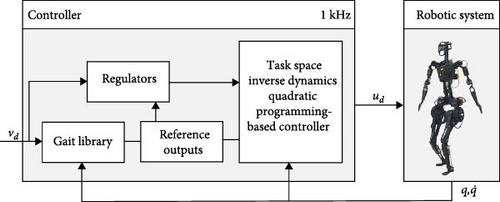
2.1. HZD Framework
The walking dynamics are modeled as a hybrid system, consisting of a sequence of continuous dynamics that represent the robot’s motion between impacts, and discrete (discontinuous) dynamics that capture the instantaneous changes occurring at impact events.
The enforcement of this constraint gives rise to the corresponding force terms, λ, in the equations of motion Equation (1).
The reset map ΔR→L represents the discrete impact event in which support transitions from the right foot to the left foot, as defined in Equation (5).
To ensure formal stability across the hybrid structure, these surfaces must remain invariant not only during continuous evolution but also through discrete transitions. By leveraging trajectory optimization, the HZD framework produces a library of optimized walking trajectories tailored to the robot’s full-body dynamics [14]. This eliminates the need for motion capture data or predefined gait datasets. Instead, virtual constraints are exploited to generate energy-efficient trajectories in both sagittal and lateral planes while enforcing physical limitations such as torque and joint bounds.
The resulting optimized trajectories form a gait library and serve as reference inputs for real-time execution. In this work, these references are tracked using a TSID controller, which ensures accurate trajectory following while maintaining full-body dynamic consistency and enforcing physical constraints, as detailed in the following section.
2.2. TSID Controller
TSID is a control framework that computes joint torques by solving a hierarchy of motion and force tasks, formulated directly in task space [10, 11]. Higher-priority objectives, such as contact consistency and swing foot tracking, are enforced before lower-priority goals like posture regularization. Each task is expressed as an equality or inequality constraint, and the full problem is solved through a sequence of quadratic programs (QPs). The specific set of tasks and their priorities can vary depending on the robot’s structure and the locomotion requirements of the application.
TSID’s task-space formulation enables intuitive control of underactuated, floating-base robots and allows for the explicit enforcement of physical constraints, including torque limits, joint bounds, and friction cones. All resulting motions are dynamically consistent with the robot’s full-body equations of motion. Due to its modularity and flexibility, TSID is particularly well-suited for complex locomotion, compliant behaviors, and multicontact planning. For a detailed mathematical formulation, we refer the reader to [12].
3. Application to a Humanoid Robot
This section describes the application of the proposed gait planning and TSID controller to the GR-1 humanoid robot model. The robot’s dynamics, hybrid walking domain structure, gait interpolation techniques, real-time tracking using TSID, and velocity regulation strategies are presented in detail. The general control concept is illustrated in Figure 1.
3.1. Robotic Model
GR-1 (Figure 2) is a torque-controlled humanoid robot developed by Fourier Intelligence. It stands approximately 1.5 m tall and weighs around 53 kg. The robot features 32° of freedom (DoF): 6 per leg, 7 per arm, 3 for the head, and 3 for the waist.
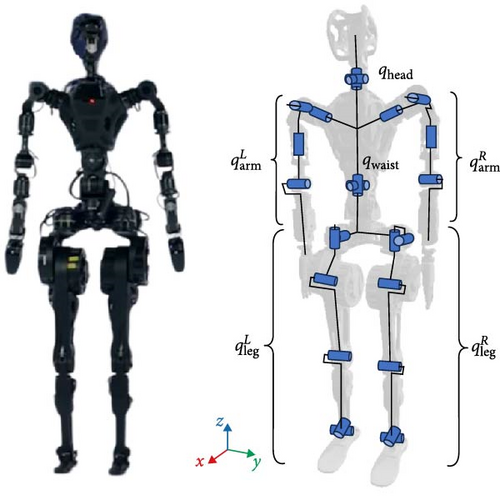
In this study, we assume that walking is symmetric between left and right stance phases when the robot’s average lateral velocity over a step is zero; otherwise, asymmetric walking is allowed. Accordingly, the GR-1 gait is modeled using two single support domains, , as illustrated in Figure 3, along with an instantaneous double support phase. The term “instantaneous” indicates that the new swing leg lifts off immediately after the previous swing leg makes contact with the ground.
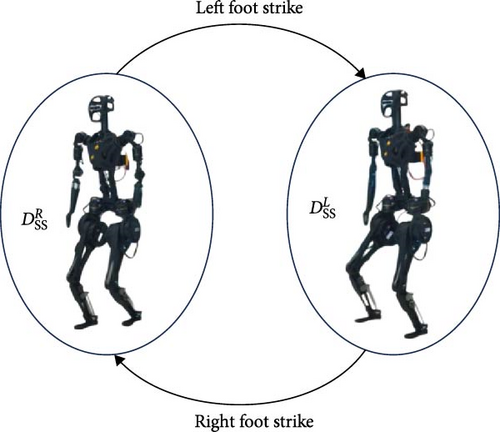
A visualization of the prescribed coordinates is shown in Figure 2, and an URDF of the robotic model detailed in this work is provided online [13].
3.2. Gait Library Planning and Optimization
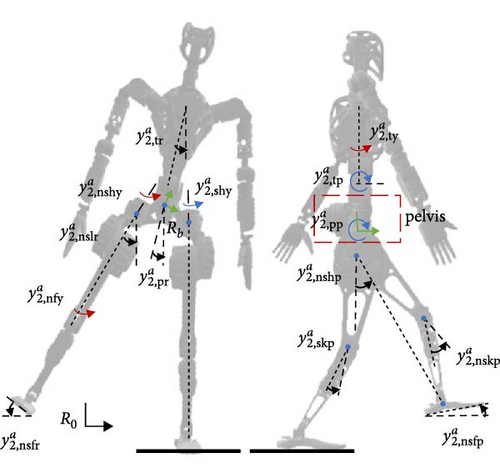
The second set of virtual constraints is rarely used in the literature [16], and to the best of our knowledge, this is the first time it has been applied to generate a complete gait library for a 3D bipedal robot. This formulation focuses on regulating the relative distance between the CoM and the robot’s feet. The torso, arms, and
During the optimization process for both groups, the ankle pitch and roll joints were treated as passive, following the approach described in [14]. Our experiments showed that this assumption leads to more stable walking. For both constraint sets, a total of 17 virtual constraints were defined, resulting in an underactuated system during the single stance phase. The head joints and any other joints not explicitly mentioned were considered fixed throughout the study, as they do not significantly influence the robot’s locomotion. Fifth-degree Bézier curves were used to parameterize the desired outputs.
The step duration for all gaits was kept constant to simplify online tracking. Torque, joint angle, and velocity limits were enforced to ensure physical feasibility on the real robot. To maintain movement stability, the waist’s rotational angles were constrained to zero, preventing upper-body inclination. Additionally, the hand joints followed a zero trajectory (rather than being fixed) to prioritize leg movements while allowing future investigation into how hand motions affect stability. Further constraints are listed in Table 1.
| Step duration | 0.3 s |
|---|---|
| Torso frame height | >0.8 m |
| Step width (distance between feet in lateral direction) | (0.15, 0.25) m |
| Mid-stance foot clearance | 0.06 m |
| Friction cone | 0.8 |
| Vertical impact velocity | (−0.5, 0) |
| Torque for stance foot pitch and roll | 0 N·m |
3.3. Real-Time Controlling Using TSID
The offline-optimized trajectories from the gait library serve as reference trajectories, sampled at 1 ms intervals to extract the positions and velocities of the CoM and feet. Additional constraints include torque and velocity limits, swing-foot flatness during motion, contact-sequence restrictions, and upright upper-body posture. A posture constraint is also applied to encourage joints to follow their default values. The tasks and their corresponding gains used in the simulation are detailed in Table 2.
| Task | Priority | Weight | Kp | |
|---|---|---|---|---|
| Torque and velocity bounds | 0 | 1 | — | |
| Feet contact | I | 1 | 6 × 500 | |
| CoM to feet tracking | I | 1 | 6 × 500 | |
| Torso orientation | I | 1 | 3 × 500 | |
| Posture regularization | I | 10−3 | Feet | 12 × 10 |
| Other | 20 × 1000 | |||
- Note: We denote by n × [.] a vector of n elements. Kd for all tasks is set to be .
3.4. Velocity Tracking and Regulation Heuristics
4. Results
4.1. Generating Gait Libraries Comparison
Each group of virtual constraints was used to generate a gait library. Optimization was performed sequentially using the previous gait as an initial guess for the next speed in the library. Table 3 shows the performance comparisons between the two groups. The comparison indicates that the second group converges with a smaller number of iterations (8% fewer) and spends less time (12% faster). Additionally, calculating the percentage difference in the objective values of the two gait libraries:
| Metric | Group 1 | Group 2 |
|---|---|---|
| Avg. number of iterations (iter) | 368 | 338 |
| Avg. time (s) | 419 | 367 |
4.2. Simulation Results
The PyBullet simulation environment [22] was used to test the control procedure. We first tuned the controllers and then evaluated their performance. The tests included stepping in place, as well as walking forward, laterally, and diagonally. We observed that the two groups of virtual constraints produced similar results in terms of tracking and walking appearance. Therefore, only the results of the second group of constraints will be shown here. The reader is referred to the accompanying submission video for demonstration results.
Figure 5 shows time-series motion tiles for the robot in PyBullet environment at a speed of 1 m/s. The output tracking and feed-forward torques for stepping in place are shown in Figures 6 and 7. Figures 8–10 correspond to the forward walking scenario at a target speed of 1 m/s along the sagittal direction.
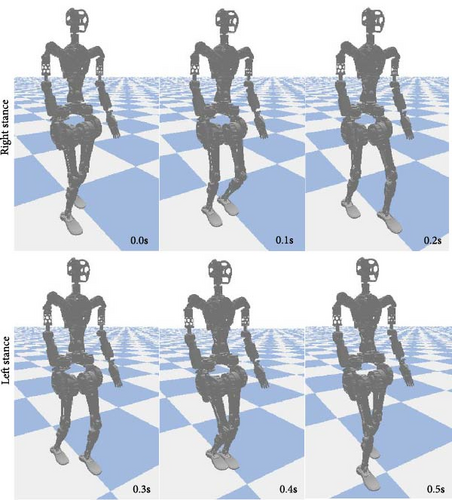
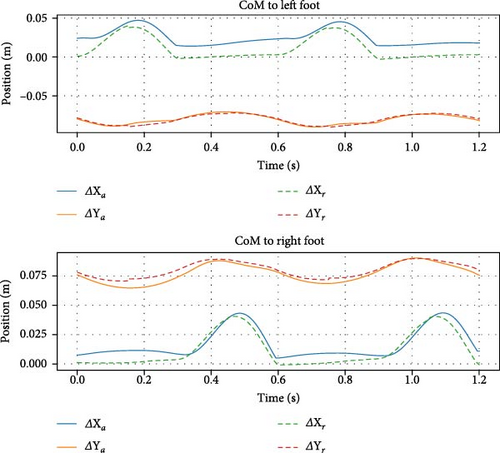
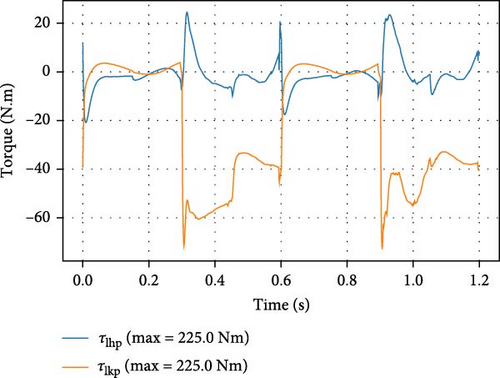
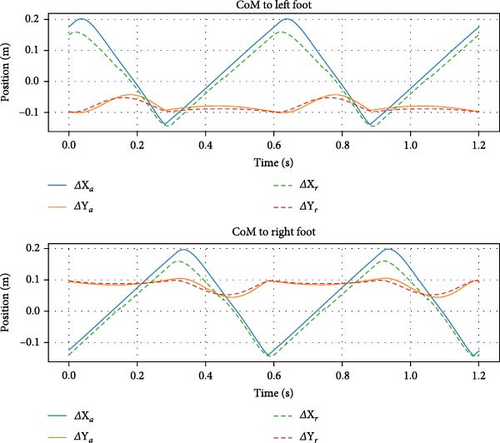
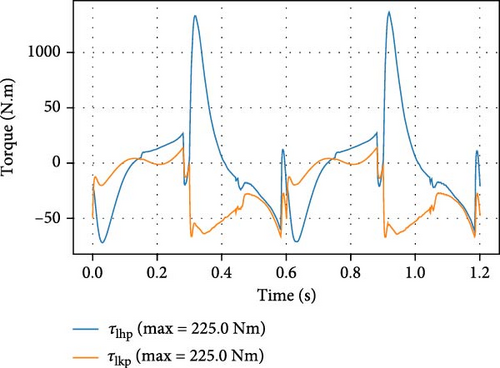
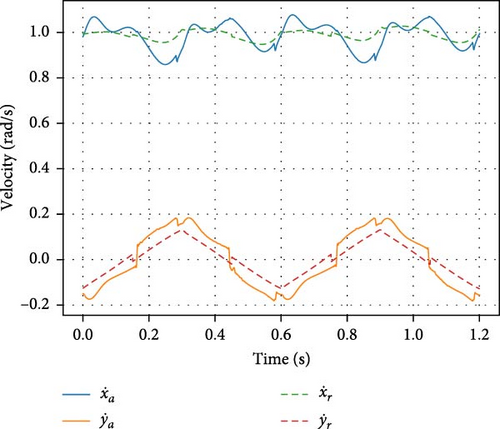
The robot’s ability to transition between several walking speeds is shown in Figures 11–13. Different scenarios are illustrated and described in each figure. This demonstrates the effectiveness of the TSID controller, combined with Raibert-like regulators, in following velocity commands.

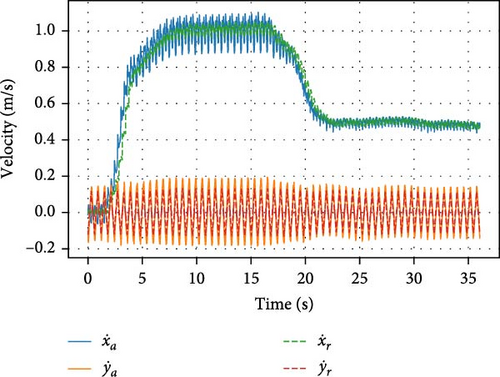
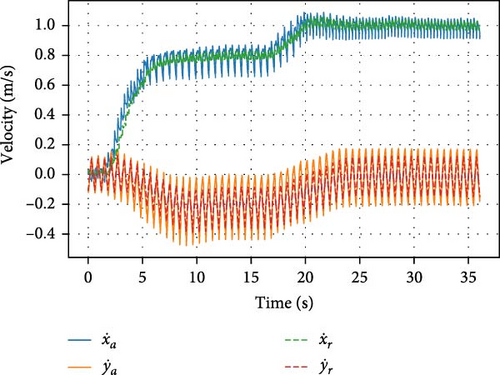
The robot’s ability to overcome external disturbances is also tested. Figure 14 shows the robot’s ability to withstand pushes in the lateral direction and in the sagittal direction during walking. As we can see from the figure, the robot was able to return to stable motion after several steps. We noticed that the robot’s ability to handle lateral pushes is less than its ability to handle sagittal pushes. This is because the motor torques of the roll joints are limited (48 N·m for the hip roll and 15 N·m for the ankle roll).
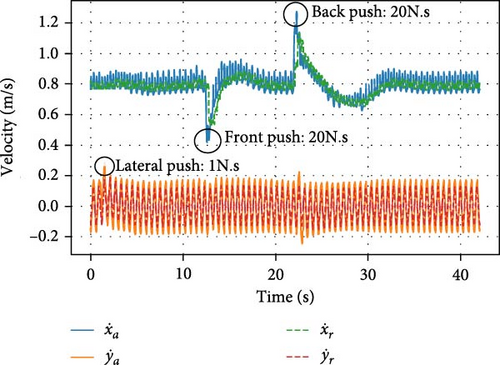
5. Discussion
Several methods have been used in the literature to track reference trajectories generated by the HZD approach, including PID control [3], analytical inverse dynamics [8], and Lyapunov-based inverse dynamics control (ID-CLF-QP) [9]. While all these methods, including the one employed in this paper, successfully track reference trajectories, each has its own advantages and limitations. This section compares the TSID controller to these methods, highlighting the motivation behind selecting TSID.
PID control offers a simple and computationally inexpensive strategy, often effective for fully actuated or slow systems. However, it does not account for full-body dynamics, has difficulty handling underactuation and contact constraints, and provides no formal stability guarantees beyond local convergence.
The orthogonal decomposition method analytically projects dynamics into the constraint-consistent space and is computationally efficient. Yet, it is limited in its ability to manage multiple simultaneous tasks, lacks a natural way to handle inequality constraints, and offers no formal stability proof.
Lyapunov-based ID-CLF-QP control provides exponential convergence guarantees through Lyapunov constraints even in hybrid systems. However, it demands precise modeling, careful Lyapunov function design, and solving a more complex QP.
In contrast, TSID provides a practical compromise between flexibility, computational efficiency, and robustness. It enables the tracking of multiple prioritized tasks, ensures full-body dynamic consistency, and handles physical inequality constraints. Although TSID does not guarantee Lyapunov stability, its modularity, versatility, and robustness to modeling inaccuracies make it highly practical for real-world applications. A summary comparison between the four methods is presented in Table 4.
| Feature | TSID | PID | Orthogonal decomposition | ID-CLF-QP |
|---|---|---|---|---|
| Main idea | Multitask QP optimization | Simple error feedback | Analytical projection | Lyapunov stability enforced QP |
| Stability guarantee | No | No (local only) | No | Yes (provable) |
| Multiple tasks | Yes (prioritized) | No | Limited (only single dominant tracking task) | Limited (only single output focus) |
| Inequality constraints | Yes | No | No | Yes |
| Contact switching | Yes (smooth via switching contact constraints) | No (basic) | Requires manual handling | Yes (designed to handle hybrid dynamics) |
| Computation cost | Medium (solve a moderate size QP) | Very low | Very Low | Medium–high (adds Lyapunov constraints/slack) |
| Implementation complexity | Medium–high (but modular) | Very low | Low | High (design CLFs carefully) |
| Robustness | Good | Poor for complex systems | Good for simple tasks | Good for simple tasks |
| Scalability to complex robots | High (with task prioritization) | Very low | Low (can become messy with many tasks) | Medium (design CLFs for many tasks) |
| Use of full-body dynamics | Yes | No | Yes | Yes |
Overall, TSID provides an effective balance between real-time performance, task flexibility, and robustness, making it highly suitable for controlling complex bipedal robots in dynamic environments.
6. Conclusion and Future Work
In this work, we presented a full-body, optimization-based framework for stable bipedal locomotion, combining offline gait generation with online trajectory tracking. By leveraging virtual constraints and full-body dynamics, we developed an energy-efficient gait library tailored to the GR-1 humanoid robot. Our comparative study revealed that virtual constraints based on CoM-to-feet positions significantly enhanced optimization performance, achieving an 8% reduction in iterations, 12% faster convergence, and an 11.6% improvement in the objective value. These constraints also simplified online tracking by inherently incorporating CoM-based stability strategies. For real-time control, we employed a TSID controller formulated as a WQP. TSID provided a practical balance between computational efficiency, task flexibility, and robustness, critical for complex bipedal locomotion. Extensive simulations demonstrated stable walking across a range of speeds and robust disturbance rejection, withstanding impulsive pushes of up to 20 N·s.
Future work will focus on hardware implementation to experimentally validate the controller’s performance under real-world conditions, including uneven terrain and unmodeled dynamics.
Conflicts of Interest
The authors declare no conflicts of interest.
Funding
No funding was received for this research.
Supporting Information
Additional supporting information can be found online in the Supporting Information section.
Open Research
Data Availability Statement
The data that support the findings of this study are available from the corresponding author upon reasonable request.



